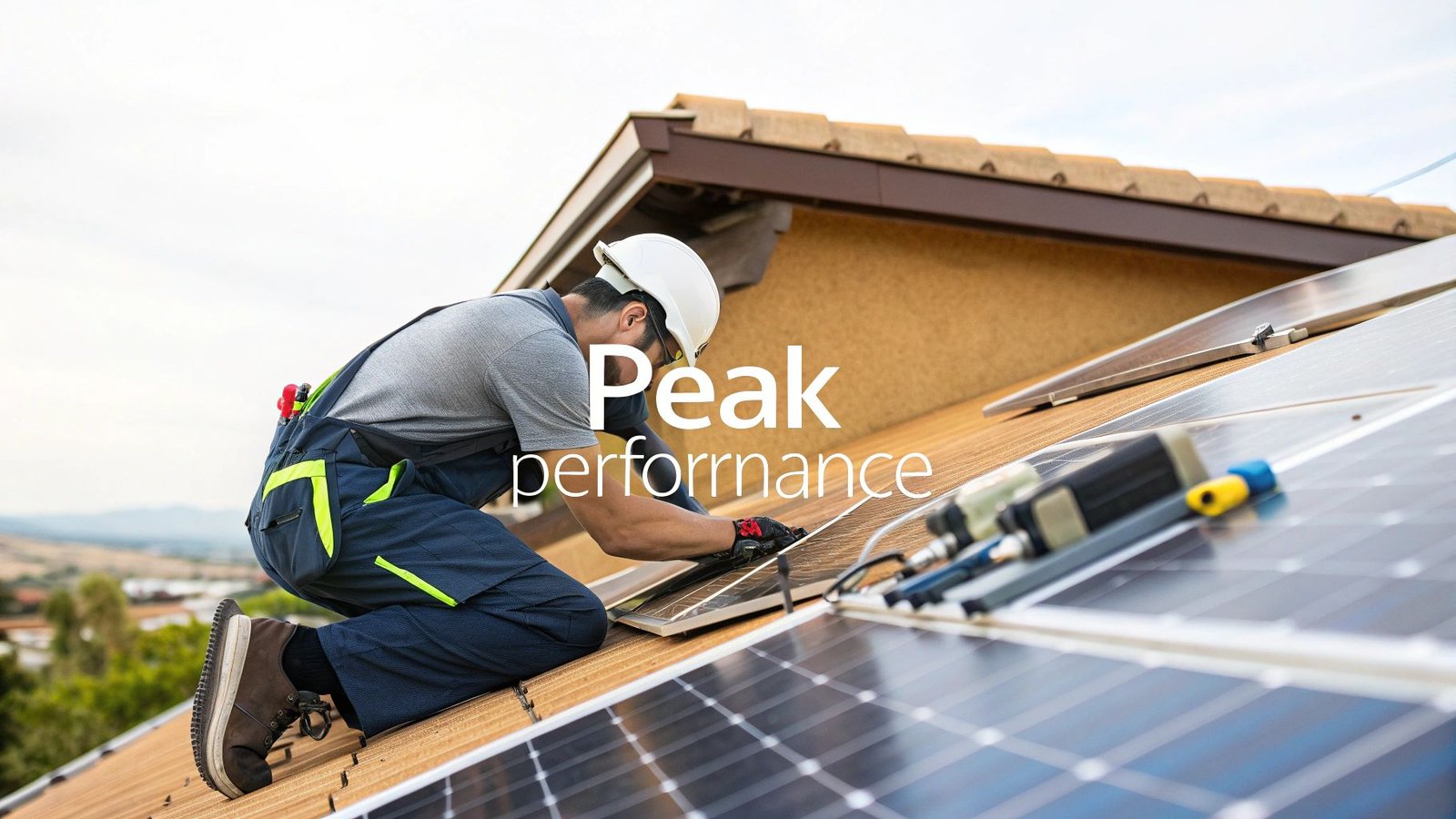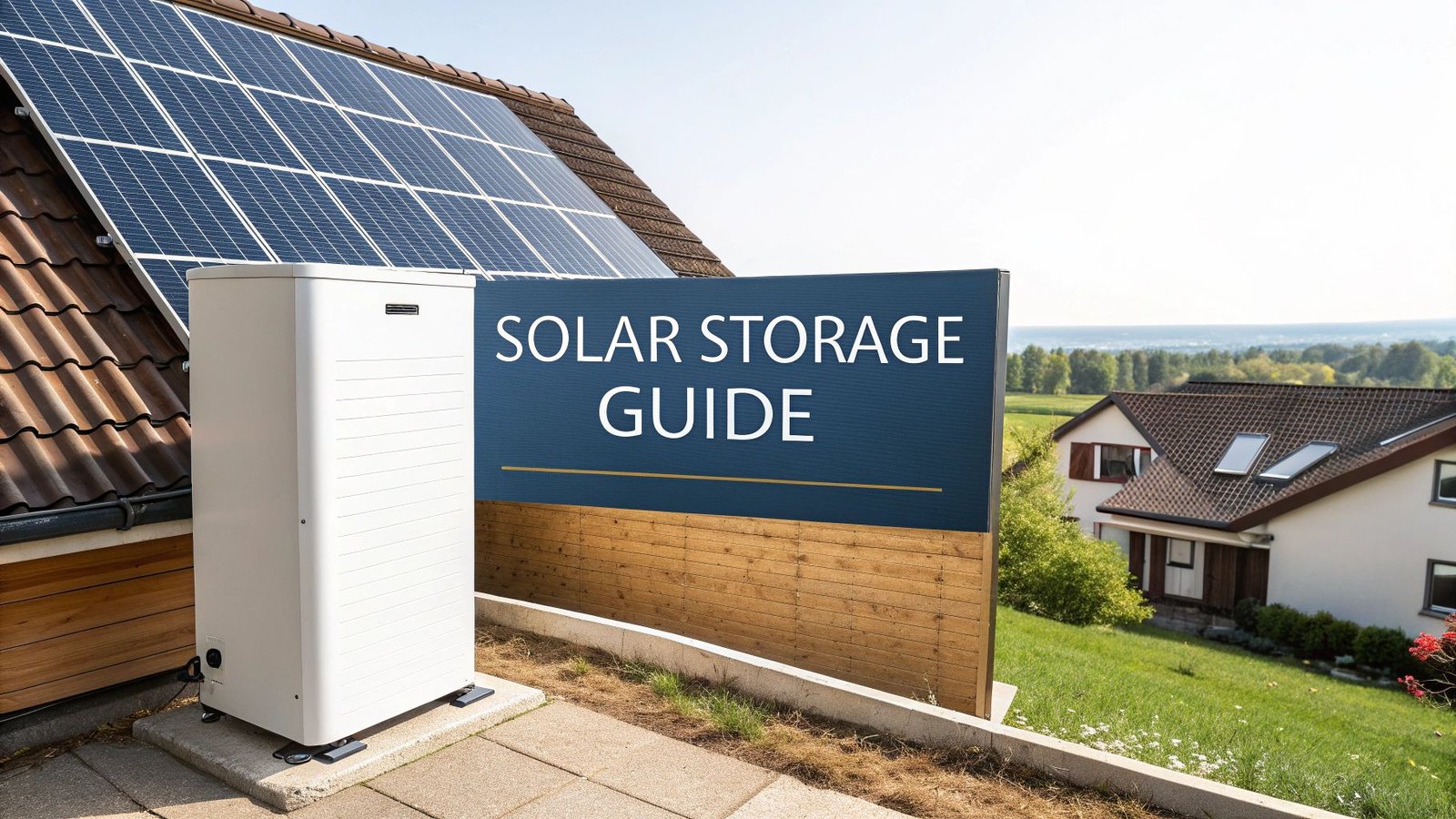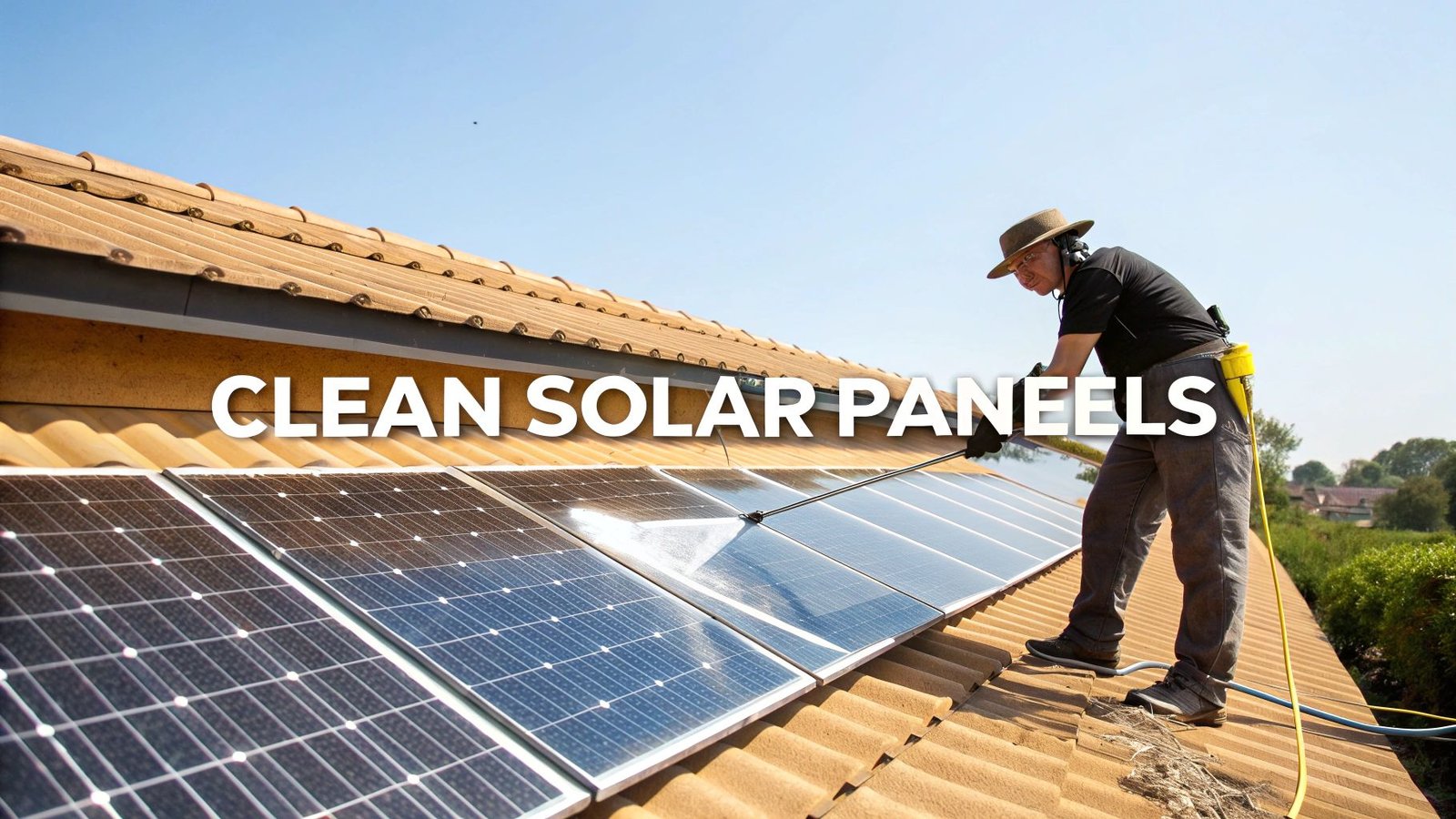At its core, solar panel servicing is a professional health check for your entire solar energy system. It’s far more than just a quick clean; it’s a deep-dive inspection to make sure every component, from the panels on your roof to the inverter on the wall, is working exactly as it should. The goal is simple: keep your system running at peak efficiency and catch small issues before they turn into big, expensive headaches.
Understanding the Value of Solar Panel Servicing
Think of your solar system like a car. You wouldn't drive it for years without an oil change or a tune-up, right? You do that maintenance to ensure it runs efficiently, stays reliable, and lasts as long as possible. Solar panel servicing is the exact same principle applied to your energy investment.
This proactive approach is crucial because performance degradation can be sneaky. A bit of dust here, a loose connection there—these things might not seem like a big deal, but over time, they can quietly chip away at your system's energy output, forcing you to pull more power from the grid and inflating your electricity bills.
Why Proactive Care Matters
Regular servicing is essentially an insurance policy for your system’s performance. By having a technician inspect everything, you're not just waiting for something to break. You’re actively preventing failures and ensuring you get the most out of your panels for their entire 25 to 30-year lifespan.
A good professional service is pretty thorough. They’ll typically cover:
- A Deep Panel Cleaning: Getting rid of all the accumulated grime, pollen, and bird droppings that literally block the sun.
- A Full Electrical Inspection: Making sure all the wires, connections, and safety isolators are secure and in good condition.
- An Inverter Health Check: The inverter is the brain of your operation, and technicians will verify it's converting DC power to usable AC power efficiently.
- A Mounting System Security Check: They'll make sure the racks and hardware holding your panels are still tight, secure, and not showing signs of corrosion.
A professional service isn't just about cleaning; it's about restoring performance. By tackling these key areas, technicians can often reclaim lost efficiency and ensure your system delivers the savings you were promised.
The Impact of Neglect on Performance
What happens if you just let it be? The drop in energy production can be surprisingly steep. Even a light film of dirt can reduce a panel's output, and when you multiply that loss across your entire array, it really adds up. Without servicing, your system's performance will degrade much faster than it should.
Take a look at how this plays out over time. The numbers show a clear story of diminishing returns without maintenance.
graph TD
subgraph Projected Energy Output Over 10 Years
A[Year 1] --> B(With Servicing: 100%)
A --> C(Without Servicing: 98%)
D[Year 3] --> E(With Servicing: 99%)
D --> F(Without Servicing: 92%)
G[Year 5] --> H(With Servicing: 98%)
G --> I(Without Servicing: 85%)
J[Year 10] --> K(With Servicing: 95%)
J --> L(Without Servicing: 75%)
end
style B fill:#90ee90
style E fill:#90ee90
style H fill:#90ee90
style K fill:#90ee90
style C fill:#ffcccb
style F fill:#ffcccb
style I fill:#ffcccb
style L fill:#ffcccb
Ultimately, solar panel servicing shouldn't be seen as an expense. It's an investment that protects your system, maximizes your savings, and gives you confidence that your panels are working as hard as you are.
The Future of Solar Panel Maintenance

The days of waiting for a solar panel to fail before fixing it are quickly becoming a thing of the past. Solar panel servicing is in the middle of a huge shift, moving from reactive repairs to proactive, tech-driven care. Think of it less like a simple check-up and more like getting a full-body MRI for your solar array—we can now see what’s happening on the inside before it becomes a real problem.
At the heart of this evolution are AI-powered diagnostics and the Internet of Things (IoT). Tiny sensors embedded in the system create a "digital twin," constantly feeding back real-time data on everything from energy output to the temperature of each panel.
Artificial intelligence then crunches all this information, learning the system's normal behavior and spotting tiny dips in performance that a human would miss. These smart algorithms can actually predict when a component might fail weeks or even months down the line. This gives technicians a chance to get ahead of the issue, minimizing downtime and stopping a small hiccup from turning into an expensive breakdown.
Smarter Diagnostics and Automation
New diagnostic tools are completely changing how we conduct inspections. For instance, using drone thermal imaging camera technology is a game-changer. A drone can fly over a huge solar farm and use thermal cameras to spot "hot spots" or other anomalies that are invisible to the naked eye, pointing directly to underperforming panels.
We're also seeing a rise in automated cleaning, especially for large-scale solar farms. Robotic systems can now clean thousands of panels with incredible precision and consistency, often using little to no water. It's a massive leap in efficiency.
By bringing all this tech together, modern solar servicing can catch and fix up to 90% of performance issues before they ever cause a serious drop in energy production. That's a huge improvement over the old way of doing things.
This wave of innovation is also driving serious growth. The global market for solar panel operation and maintenance (O&M) was valued at around $5.83 billion and is expected to climb to $6.45 billion by 2025. It's clear that smarter, tech-forward maintenance is not just a trend—it's the future.
The Real Payoff of Regular Servicing

It’s easy to look at solar panel servicing as an optional expense, something you can skip to save a few bucks. But that line of thinking often leads to silent, invisible losses that really add up. These aren't just abstract numbers; they translate directly into lower energy production and higher electricity bills, hitting you right in the wallet.
Think of it like this: even a fine layer of dust, pollen, or bird droppings can act like a film, blocking precious sunlight from reaching the cells. It might not look like much, but spread across your entire array, it can cause a surprising drop in efficiency. In fact, some studies show that environmental buildup can cut a panel's output by up to 30% without regular cleaning.
This simple routine of keeping your panels clean and inspected directly translates into more energy produced and more money saved each month. It's about making sure your solar panels deliver the financial returns you expected from day one.
Protecting Your System and Your Warranty
Beyond just a good cleaning, professional servicing is really about spotting small issues before they snowball into expensive catastrophes. A trained technician can catch things you'd never see from the ground, like a loose electrical connection, early signs of corrosion on the mounting hardware, or a component in the inverter that's starting to fail.
It’s the classic "ounce of prevention" scenario. A small investment in a routine service call can easily prevent a multi-thousand-dollar component failure down the road. You’re choosing a quick tune-up over a potential system overhaul.
This proactive approach is also crucial for keeping your manufacturer warranties intact. Many solar panel and inverter companies require proof of regular, professional maintenance to honor their warranty claims. If you skip servicing and something goes wrong, you could be on the hook for the full cost of a repair that should have been covered.
Keeping an eye on your system’s daily output is also a great way to catch problems early. To learn more about this, check out our guide on choosing the right solar monitoring system.
Your Essential Solar Servicing Checklist
Ever wondered what really happens during a professional solar panel service? It’s a lot more than just a quick hose-down. Think of it as a comprehensive health check for your entire system, designed to catch small issues before they become big, expensive problems.
The service always starts with a careful cleaning. A pro will use gentle, non-abrasive tools and specialized, biodegradable soaps to clear away the grime, pollen, and bird droppings that are notorious for blocking sunlight. This alone can give your energy production an immediate and noticeable boost.
But the real value of a professional service lies in what comes next—a deep dive into the electrical and structural health of your entire setup.

Core Inspection And Safety Checks
Once the panels are sparkling clean, the technician shifts focus to the system's brain and bones. This is where their expertise truly shines, as they’re trained to spot subtle signs of wear and tear that the average homeowner would easily miss.
A thorough service will always cover these key areas:
- Inverter Performance Analysis: The inverter is the heart of your solar system, converting DC power from the panels into the AC power your home uses. Technicians will check its performance data, look for any logged error codes, and ensure the cooling fans are free of debris to prevent overheating.
- Wiring And Connection Inspection: Every electrical connection is inspected to make sure it's tight and secure. Frayed wires or loose connections aren't just a performance drain—they're a serious safety hazard.
- Mounting Hardware Verification: The tech will physically inspect the racking and mounting hardware that secures your panels to the roof. They’ll check for tight bolts, signs of corrosion, and any evidence of structural stress that could compromise the system's integrity over time.
For an even more detailed breakdown of what a technician looks for, you can explore our complete solar panel maintenance checklist.
Comparing Manual And Automated Cleaning Methods
When it comes to keeping panels clean, you have a couple of options. While traditional manual cleaning is still the go-to for most residential systems, automated solutions are gaining serious traction, especially for larger commercial installations. The choice really depends on your system's size, accessibility, and budget.
Here’s a look at how the two approaches stack up:
pie
title Cleaning Method Suitability
"Manual Cleaning" : 65
"Automated Cleaning" : 35
Ultimately, both methods get the job done. Manual cleaning offers a hands-on inspection that can catch other issues, while automated systems provide a level of consistency that's impossible to match by hand, ensuring panels are always operating at their peak.
How Often Should You Service Your Solar Panels?

So, how often do you actually need to call in a pro for your solar panels? There isn't a single, magic number for everyone. Think of it less like a rigid car maintenance schedule and more like a health check-up—the right frequency really depends on your specific situation.
Several factors come into play here. Your local climate, the type of system you have, and even what’s happening in your neighborhood can all affect how often you need a professional to take a look.
For most homeowners, a professional service every one to two years is a solid rule of thumb. But that’s just a starting point. The biggest wild card is your home's location. If you’re in a dry, dusty climate or live near a new construction zone, that fine layer of grime can build up fast, putting a dent in your energy production. In that case, you'll probably want more frequent cleanings.
The same goes if your home is surrounded by big, leafy trees. Fallen leaves, pollen, and bird droppings can become a real problem, so you might need to schedule service more often to keep everything clear and running efficiently. The idea is to get ahead of these environmental factors before they start costing you money.
It's Different for Every System
The size and purpose of the solar array also make a huge difference. The needs of a small residential setup are worlds away from a massive solar farm powering an industrial complex. The investment is different, and so is the maintenance strategy.
Here’s a quick breakdown to give you a better idea:
gantt
title Recommended Service Frequency by System Type
dateFormat YYYY-MM-DD
axisFormat %Y
section Residential Systems
Annual Check-up : 2024-01-01, 24m
section Commercial Systems
Annual Service : 2024-01-01, 12m
section Utility-Scale Systems
Continuous Monitoring & Maintenance : 2024-01-01, 3m
For most homeowners, here's a simple takeaway: scheduling a professional solar service every 18 months is a fantastic strategy. It’s frequent enough to prevent major buildup and lets a technician catch things like loose connections or inverter glitches while they’re still minor fixes.
A Sample Maintenance Calendar
Sometimes, seeing a schedule laid out makes it easier to manage. You can use this simple calendar as a guide and tweak it based on what you see happening with your own system.
A Simple 2-Year Servicing Cycle
| Timeline | Recommended Action |
|---|---|
| Month 6 | Do a quick visual check from the ground. Look for any obvious debris. |
| Month 12 | Check your monitoring app. Has your energy output dropped unexpectedly? |
| Month 18 | Time to schedule a professional solar panel servicing. |
| Month 24 | Keep an eye on your energy output and get ready for the next cycle. |
At the end of the day, the best thing you can do is pay attention. Keep an eye on your system’s performance and be aware of your local environment. A little bit of proactive care will ensure your solar panels keep working hard for you for years to come.
Choosing Between DIY and Professional Servicing
So, should you tackle solar panel servicing yourself or call in a pro? This is a question every solar owner asks eventually. The DIY route can seem tempting—a chance to save a few bucks. But on the other side of the coin, a professional brings expertise and safety that are tough to match on your own.
Ultimately, your decision boils down to balancing potential savings against some very real risks. While a quick hose-down might feel simple enough, there's a lot more to a proper service than just a wash. The real question you have to ask yourself is: are the short-term savings of doing it yourself worth the long-term risks to your system, your warranty, and your safety?
The Case For Professional Servicing
When you hire a professional, you're not just paying for a wash and wipe. You're investing in years of experience, specialized tools, and a trained eye that can spot subtle problems the average homeowner would easily miss. A good technician knows exactly what to look for—the early signs of wear on a cable, a potential electrical fault, or a loose mounting bracket.
Think of a professional service call as a comprehensive health check for your entire solar array. It's designed to catch those small, hidden issues—like a frayed wire or a struggling inverter component—before they snowball into a complete system failure.
And let's be honest, working on a roof around high-voltage equipment is risky business. Professionals show up with the right safety gear and the training to navigate these dangers, keeping both themselves and your property safe. Trying to do this without the proper know-how can lead to serious injury or costly damage to your panels and roof.
Weighing The Risks Of A DIY Approach
The idea of saving a hundred bucks or so is definitely appealing, but going the DIY route with solar servicing is packed with potential pitfalls. One of the classic mistakes we see is people using the wrong equipment. A pressure washer can blast water past the panel’s seals, and harsh soaps can strip the anti-reflective coating or leave a film that just attracts more grime.
Beyond just cleaning, attempting any kind of electrical inspection on your own is incredibly dangerous. It’s also a surefire way to void your manufacturer warranties, which means you’ll be on the hook for any and all future repair costs. For anything more involved than a gentle rinse you can do from the ground, the risks almost always outweigh the rewards. If you are set on a light cleaning, our guide on how to clean solar panels covers the essential safety dos and don'ts.
To lay it all out, let's break down how the two approaches stack up against each other.
DIY vs Professional Servicing Breakdown
Here’s a detailed comparison to help you decide which path makes the most sense for you, weighing the costs, safety concerns, and overall effectiveness.
| Factor | DIY Servicing | Professional Servicing |
|---|---|---|
| Cost | Low initial cost for supplies, but a high risk of making an expensive mistake. | Higher upfront cost (typically $150 – $350) but helps prevent major, costly repairs down the road. |
| Safety | High risk of falls and electrical shock without professional training and safety equipment. | Low risk. Technicians are trained, insured, and equipped to handle the job safely. |
| Effectiveness | Mostly limited to surface cleaning. You can't diagnose technical or electrical issues. | A comprehensive inspection that identifies underlying electrical and structural problems. |
| Warranty | A big risk of voiding manufacturer warranties for your panels and inverter. | Preserves your warranty. Professionals follow procedures that keep your coverage intact. |
In the end, while DIY might save you money in the short term, a professional service is an investment in the long-term health, safety, and performance of your solar energy system.
Got Questions About Solar Panel Servicing? We've Got Answers.
Even after you get the basics down, it’s completely normal to have more questions about keeping your solar panels in top shape. Thinking about the specifics of system care can feel a little overwhelming, but getting the right answers is usually simpler than you’d expect. Let's tackle some of the most common questions we hear from homeowners just like you.
What's This Going to Cost Me?
It’s the first thing on everyone's mind, and for good reason. For a standard home solar setup, a professional service call typically runs between $150 and $350.
What causes that price range? It really comes down to a few things: the total size of your system, how tricky it is to get up on your roof, and just how deep of an inspection you need.
Can I Just Clean the Panels Myself?
It’s tempting to save a few bucks and do it yourself, and for light cleaning, you absolutely can—as long as you can do it safely from the ground. You don't need much to get started.
Here’s your simple DIY cleaning kit:
- A soft brush or a cloth on an extension pole.
- A squeegee with a plastic or rubber blade (nothing abrasive!).
- A bucket of water with a little biodegradable soap.
- A regular garden hose with a spray nozzle.
The most important rule? Never, ever use a pressure washer. The intense spray can strip the anti-reflective coating right off your panels and damage the seals that keep water out. Stick to gentle cleaning.
When Should I Absolutely Call a Professional?
Knowing your limits is key. While a little dust and grime is one thing, some issues are clear signals that you need an expert's eye.
Give a professional a call right away if you spot a major, unexplained drop in energy production, see any physical damage like cracks or burns, or if your inverter is flashing an error code. These are signs of problems that go far beyond a simple cleaning.
Regular check-ups really do pay off over the long haul. The chart below illustrates how staying on top of maintenance helps you get the most energy out of your system year after year.
xychart-beta
title "Projected 10-Year Energy Output"
x-axis "Year" [1, 2, 3, 4, 5, 6, 7, 8, 9, 10]
y-axis "Efficiency (%)" [80, 100]
line "With Servicing" [100, 99.5, 99, 98.5, 98, 97.5, 97, 96.5, 96, 95]
line "Without Servicing" [98, 95, 92, 89, 85, 82, 80, 78, 76, 75]
Ready to ensure your solar system is performing at its best? The expert team at Radiant Energy offers comprehensive solar panel servicing to protect your investment and maximize your energy savings. Schedule your solar panel service today and keep your system running smoothly.




